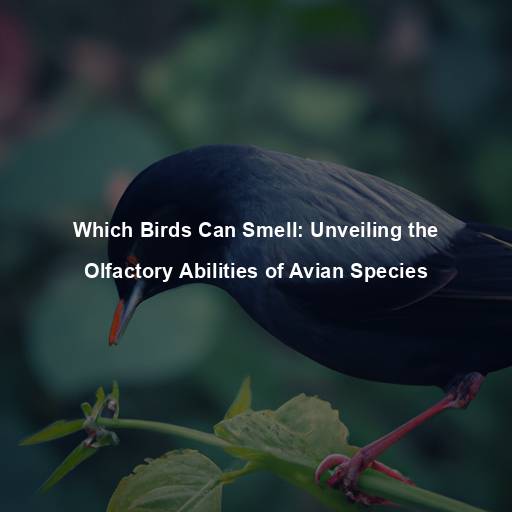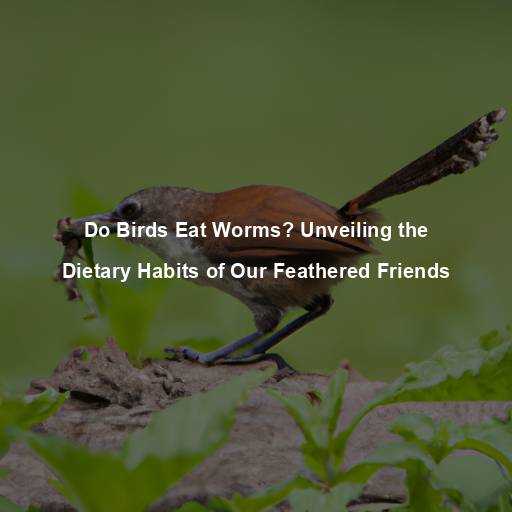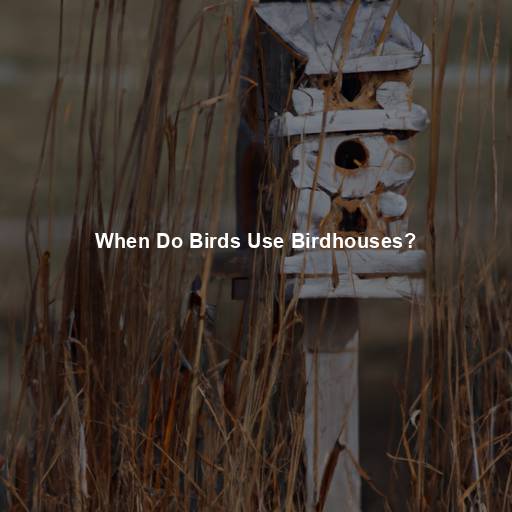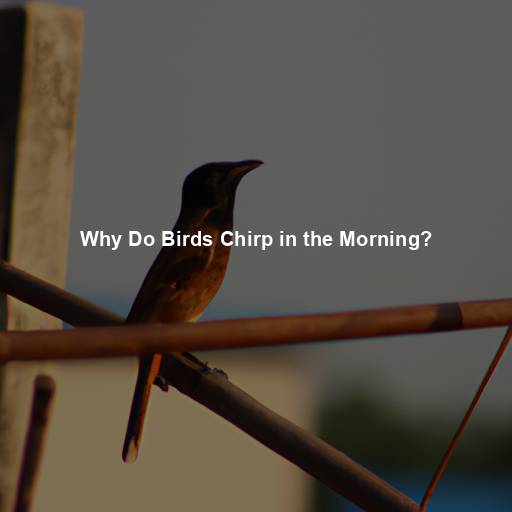Which Birds Can Smell: Unveiling the Olfactory Abilities of Avian Species
Last Updated on October 20, 2023 by Evan
Contents
- 1
- 2 The Importance of Olfaction in Birds
- 3 Birds with Exceptional Olfactory Abilities
- 4 The Evolutionary Significance of Avian Olfaction
- 5 The Lesser-Known Avian Olfactory Heroes
- 6 Unraveling the Mysteries: The Science of Avian Olfaction
- 7 An Olfactory World: Birds’ Unique Perspective
- 8 The Complexities of Avian Olfaction
- 9 FAQs: Which Birds Can Smell
Birds, with their vibrant plumage and melodious songs, have long captivated the human imagination. While we often attribute their remarkable abilities to keen eyesight and acute hearing, there is another sense that plays a significant role in their daily lives: the sense of smell. In this article, we delve into the fascinating world of avian olfaction, exploring which birds possess the ability to smell and how they utilize this sense to navigate their environment.
The Importance of Olfaction in Birds
Avian Olfactory System: A Brief Overview
It’s time to dispel the notion that birds lack a sense of smell. Contrary to popular belief, our feathered friends actually have olfactory systems, though the level of complexity differs from species to species. While their olfactory bulbs may not be as prominent as those of mammals, they are still fully operational. Surprisingly, the reliance on the sense of smell varies greatly within the avian world, posing a fascinating puzzle for scientists to unravel.
The Role of Smell in Foraging and Feeding
While birds are renowned for their visual acuity when it comes to locating food, scent cues also play a crucial role in their foraging strategies. Certain bird species, such as vultures and kiwis, have a heightened sense of smell, which aids them in locating carrion or earthworms, respectively. By detecting the scent of decaying flesh or underground prey, these birds gain a distinct advantage in their search for sustenance.
Olfaction and Nesting Behavior
Smell is not only important for finding food; it also influences avian nesting behavior. Some species, like the Procellariiformes (albatrosses, petrels, and shearwaters), rely on their sense of smell to locate their nesting sites amidst vast oceanic environments. These birds can detect the odor of their nesting burrows, allowing them to return to their specific breeding grounds year after year.
Birds with Exceptional Olfactory Abilities
Turkey Vultures: The Masters of Scavenging
Turkey vultures (Cathartes aura) are renowned for their exceptional olfactory prowess. These carrion-eating birds have an acute sense of smell, allowing them to detect the scent of decaying flesh from great distances. By soaring high above the ground, they can locate carrion even when it is hidden from sight. This remarkable ability enables them to outcompete other scavengers and play a vital role in maintaining ecosystem balance.
Kiwis: Earthworm Connoisseurs
Nestled amidst the beguiling wilderness of New Zealand, there exists a remarkable avian inhabitant known as the kiwi bird, distinguished by its diminutive stature and striking wingless existence. A singular fascination drives this enigmatic creature: the pursuit of earthworms, their true gastronomical obsession. Surprisingly, despite their apparent limitations, kiwis possess a perplexingly advanced olfactory system, enabling them to detect the elusive earthworms concealed beneath the verdant forest floor. Guided by their elongated beaks and an astute sense of smell, these extraordinary kiwis manifest the awe-inspiring spectrum of avian adaptations tailored to the olfactory realm.
Albatrosses: Homing in on Scent
Albatrosses (Diomedeidae) are renowned for their transoceanic migrations, covering thousands of miles to return to their breeding grounds. Central to their navigational abilities is their exceptional sense of smell. By detecting the scent of their nesting sites, often located on remote islands, albatrosses can successfully find their way home across vast stretches of open ocean. This remarkable olfactory skill allows them to maintain lifelong pair bonds and ensure the survival of their offspring.
The Evolutionary Significance of Avian Olfaction
The Trade-Off with Vision
The avian world is a fascinating labyrinth of sensory prowess, where birds navigate a bewildering array of evolutionary choices. An intriguing aspect lies in the stark differences in sensory reliance, as some birds gracefully dance through life guided by their keen sight and sharp hearing, while others elevate the power of scent to soaring heights. It seems as though nature herself has bestowed upon our feathered friends a dazzling array of sensory tools, sculpted by the intricate dance of trade-offs and adaptations. Whether it’s the regal raptors and entrancing songbirds, majestically soaring through open skies, or the mysterious dwellers of dimly lit realms, these birds embody the perplexing beauty of evolution’s tapestry, each species carving their own unique niche in the symphony of life.
Unraveling the Genetic Basis
Exploring the intricate genetic landscape behind avian olfactory adaptations is a task that brims with intrigue and fascination. Researchers embark on a thrilling quest, delving into the genomes of birds endowed with exceptional smelling abilities, driven by the desire to decipher the intricate genetic mechanisms underpinning this remarkable sensory prowess. The profound results of this investigation not only unravel the captivating evolutionary journey of avian olfaction, but they also offer profound glimpses into the vast realm of sensory perception at large, leaving us perplexed and astounded.
Pigeons: More than Just City Dwellers
When we think of pigeons, we often picture them bustling through crowded city streets or perching on urban rooftops. However, recent research has unveiled a surprising secret about these ubiquitous avian creatures—they possess a remarkable sense of smell. Pigeons, belonging to the Columbidae family, are now recognized as capable olfactory navigators, challenging our preconceived notions about their sensory abilities.
The Pigeon’s Olfactory Journey
The discovery of pigeons’ olfactory prowess began with a series of experiments conducted by Dr. Anna Gagliardo and her team at the University of Pisa in Italy. They found that pigeons possess an impressive ability to navigate using scent cues alone, even in the absence of visual landmarks. These findings shed new light on the remarkable complexity of avian olfactory systems and their role in avian navigation.
Unraveling the Olfactory Mechanisms
Further research into the pigeon’s olfactory abilities revealed intriguing insights into the underlying mechanisms. It appears that pigeons rely on a combination of olfactory cues, including subtle variations in scent intensity and the distribution of odor plumes. By detecting these olfactory signals, pigeons can accurately navigate their surroundings, even in unfamiliar territory or when visual cues are limited.
A Potential Evolutionary Advantage
The remarkable ability of pigeons to rely on their sense of smell has left scientists buzzing with curiosity about the evolutionary advantage it provides. Could it be that these feathered urban dwellers have honed their olfactory senses as a direct response to their bustling city lifestyle? In the concrete jungles where towering buildings obscure visual landmarks and vistas change with alarming frequency, perhaps relying on scents for navigation and survival proves to be a remarkably advantageous strategy. By harnessing the power of their noses, pigeons expertly navigate the labyrinthine complexities of urban landscapes, effortlessly locating nourishment and secure roosting spots.
The Lesser-Known Avian Olfactory Heroes
Procellariiformes: Masters of Oceanic Odors
In the captivating world of avian wonders, one cannot help but marvel at the olfactory prowess showcased not only by the renowned turkey vultures, kiwis, and albatrosses but also by a fascinating array of other bird families. Among these, the Procellariiformes, a remarkable group of seabirds encompassing the likes of albatrosses, petrels, and shearwaters, have honed their olfactory senses to amaze and perplex us all. With their uncanny ability to detect the delicate scents intertwined with feeding grounds and nesting sites, these feathered navigators fearlessly venture across vast expanses of the open ocean, leaving us astounded by their unwavering accuracy. Surely, nature’s enigmatic wonders never cease to astonish.
Tube-Nosed Birds: Sniffing out Distant Scents
In the fascinating world of Procellariiformes, a family of avian wonders, tube-nosed birds emerge as true masters of the senses. With their elongated, cylindrical nostrils, these mesmerizing creatures possess a superpower beyond imagination – the ability to sniff out the faintest scent from afar. By harnessing this remarkable olfactory prowess, tube-nosed birds navigate the vast expanses of their habitat, securing nourishment, seeking the perfect haven for nesting, and even discerning their own kind in bustling colonies. It is this extraordinary adaptation that propels these birds to thrive against all odds in the most awe-inspiring corners of our planet.
Parrots: A Surprising Olfactory Twist
Parrots, known for their vibrant plumage and exceptional mimicry, have also demonstrated an unexpected olfactory dimension. While their olfactory abilities may not be as pronounced as those of vultures or albatrosses, recent research suggests that parrots possess a functional olfactory system. This newfound understanding challenges previous assumptions about the sensory perception of these charismatic birds and opens up new avenues for exploration.
Unraveling the Mysteries: The Science of Avian Olfaction
The Complexities of Avian Olfactory Receptors
The captivating world of avian olfaction is a mesmerizing labyrinth, where researchers navigate through the enigmatic corridors of olfactory receptors and neural pathways. Despite birds having a smaller arsenal of olfactory receptor genes than their mammalian counterparts, these receptors astound with their breathtaking diversity. Delving into the depths of this intricate domain, scientists strive to unravel the secrets of how these receptors interact and unravel the enigmatic puzzle of the specific scent molecules they detect. It’s a thrilling journey filled with perplexing twists and turns that never fails to ignite curiosity and fascination.
Olfactory Learning and Memory in Birds
Birds have more to them than just their beautiful songs and colorful feathers. It turns out, they also have a knack for sniffing out scents and remembering them with astonishing precision. This mind-boggling ability allows them to link particular smells to important moments in their lives, like locating a scrumptious meal or identifying their potential soulmates. Scientists studying this fascinating area of avian olfaction have unearthed a treasure trove of knowledge about the intricate workings of bird brains and how they process and retain olfactory information.
The Future of Avian Olfactory Research
As we delve deeper into the fascinating realm of avian olfaction, the scientific community finds itself captivated by the myriad possibilities that lie ahead. With every stride we take towards unraveling the intricate genetic blueprint of olfactory adaptations in birds, a tapestry of perplexing discoveries emerges, illuminating the complex web of genes and mechanisms responsible for their extraordinary sense of smell. Beyond the realm of feathers and flight, this newfound knowledge opens doors to realms of conservation and animal behavior, where we can witness the profound implications of avian sensory perception. Embarking on this journey of unraveled mysteries, we delve into uncharted territories, unearthing the secrets behind the avian world’s remarkable olfactory abilities.
Frigatebirds: A Whiff of Fishy Business
Step aside, fellow avian enthusiasts, because the frigatebird is breaking boundaries once again! These remarkable creatures, renowned for their mesmerizing aerial displays and uncanny penchant for piracy, have recently unveiled a surprising new superpower – an exquisite sense of smell. Found in sun-soaked tropical and subtropical regions, frigatebirds have astounded researchers with their ability to sniff out pockets of fish-filled havens. By adeptly tracking intoxicating scent trails, these feathered marvels enhance their hunting prospects, paving the way for more bountiful feasts amidst the vast open seas.
New World Vultures: Nature’s Sanitation Crew
When it comes to the fascinating world of New World Vultures, it’s not just the turkey vultures that have some impressive sniffing skills. Black vultures and California condors, both members of the Cathartidae family, also rely on their sense of smell to track down their next meal of decaying carcasses. This intriguing adaptation underscores the crucial role of olfaction in their unique ecological niche as the unsung heroes of nature’s cleanup crew.
Imagine being a seabird, braving the vast stretches of stormy seas and desolate islands. Now, picture relying on something other than your keen eyes to guide you back home. That’s where petrels come in – these extraordinary creatures have unveiled their olfactory prowess. Whether it’s navigating through the pitch-black night or finding their way amidst bustling colonies, storm petrels and gadfly petrels use their extraordinary sense of smell to sniff out the distinct odors of their burrows.
An Olfactory World: Birds’ Unique Perspective
Sensory Integration: The Multimodal Experience
The world of birds is a mesmerizing symphony of senses. We have long known that birds rely on their keen eyes and ears to navigate their surroundings, but did you know that they also possess a secret weapon – their sense of smell? Yes, you heard it right! The integration of olfactory information in avian perception is like a hidden treasure, unlocking a whole new level of sensory perception for our feathered friends.
Olfaction and Social Interactions
Birds’ sense of smell not only aids in survival and navigation but also influences their social interactions. For species that rely on scent cues for mate selection, olfaction plays a crucial role in finding suitable partners and maintaining pair bonds. By detecting pheromones and individual scent signatures, birds can communicate information about their identity, reproductive status, and even territory ownership.
Olfaction and Migratory Behavior
Birds have always fascinated us with their incredible migratory journeys, but did you know that their sense of smell plays a crucial role in their epic adventures? Scientists have discovered a fascinating connection between certain bird species and their olfactory abilities, revealing how scent cues guide them through their long-distance migrations. Take the Arctic terns and red knots, for example – these remarkable birds use their finely tuned noses to detect subtle variations in odors, helping them navigate their routes with uncanny precision. With these scent clues, they can make wise decisions about rest stops, find the best food sources, and even spot potential dangers along their epic migration paths.
The Complexities of Avian Olfaction
The Evolutionary Puzzle
The mesmerizing enigma of avian olfactory abilities keeps evolutionary biologists incessantly intrigued. With a stunning array of species showcasing either heightened or diminished sense of smell, unveiling the forces behind these evolutionary adaptations remains an alluring quest. The intricate interplay between ecological circumstances and the flourishing or fading of olfactory prowess provides a captivating tapestry for researchers to unravel. As they meticulously navigate this intricate labyrinth, the puzzle of avian olfaction gradually comes into focus, revealing an astonishing landscape of natural wonder.
The Role of Genes and Gene Expression
Unraveling the mysteries of avian olfaction is an intricate expedition, fraught with the enigmatic complexities of genetic exploration. Visionary researchers delve into the intricate realm of genes, painstakingly dissecting the intricate mechanisms governing the production of olfactory receptors and the intricate dance of gene expression within the avian olfactory system. Through an awe-inspiring comparison of avian genomes, varying in their olfactory prowess, these valiant scientists aspire to unearth the elusive genetic transformations that lie at the heart of avian olfaction’s captivating diversity. Prepare to be enthralled by the perplexing world of avian olfaction – where nature’s secrets unfurl with astonishing burstiness.
Environmental Influences on Olfactory Development
Birds’ sense of smell is a fascinating field of study, as it’s not just their genetic makeup that determines how they perceive odors. Environmental factors also come into play, shaping their olfactory abilities. For instance, during crucial stages of development, birds’ exposure to particular scents can have a lasting impact on their neural connections and sensitivity to different aromas. This knowledge unravels the incredible plasticity and adaptability of avian olfactory systems, making it an intriguing subject to explore.
FAQs: Which Birds Can Smell
What is the sense of smell in birds?
Birds, those enigmatic creatures that grace our skies, have long been underestimated in their olfactory prowess. It’s a tangled web of confusion, with whispers of misinformation permeating the air. While it’s true that not all birds possess the sniffing capacities of their mammalian counterparts, it’s a fallacy to label them all as scent-challenged. The truth is, some avian species have honed their olfactory senses to impressive levels, offering a fragrant tapestry of intrigue and survival in their daily lives.
Which birds have a strong sense of smell?
Several bird species have a remarkable sense of smell. Turkey Vultures are known for their exceptional ability to detect the scent of decaying flesh, allowing them to locate carrion from a considerable distance. Albatrosses, shearwaters, and petrels, which are seabirds, can identify fish oils and other odors on the water’s surface, helping them find food sources. Kiwis, a flightless bird from New Zealand, also possess a keen sense of smell, which assists them in foraging for invertebrates in the forest floor.
Do pigeons have a sense of smell?
Yes, pigeons have a sense of smell, but their olfactory capabilities vary among different breeds. Homing pigeons, for instance, are known for their exceptional ability to navigate long distances back to their home loft, often relying on their sense of smell to detect specific odors present at their release site. However, not all pigeon species possess the same level of olfaction, and some rely more on visual cues and memory rather than smell for navigation.
Can birds smell food?
Yes, many bird species can smell and use their sense of smell to locate food. For example, certain birds like the American Crow have been observed using their sense of smell to find hidden food items or detect carcasses. Some birds even have specialized olfactory adaptations, such as specialized nasal structures or a large number of olfactory receptors, allowing them to detect specific scents associated with food sources.
Are there any birds that have a poor sense of smell?
Birds, like humans, have their own unique ways of navigating the world around them. While some species have a keen sense of smell, others rely more heavily on their impressive vision to hunt and survive. Take raptors, for example, such as majestic eagles and hawks, who have sharpened their eyesight instead of developing a strong sense of smell. Similarly, certain bird species adapted to life in open habitats have shifted their reliance to visual and auditory stimuli, making the most of the cues available to them in their environment. It’s fascinating to consider how even birds with a diminished sense of smell can still detect certain odors and respond to the scents that surround them.
Can birds detect human scent?
Birds generally have the ability to detect human scent, although their responses can vary. In some cases, certain bird species may become more cautious or alert when they detect human odor, especially if it is associated with potential danger. However, this reaction can also depend on the bird species, their previous experiences with humans, and the context in which the scent is detected. Some birds, particularly those found in urban environments, may become habituated to human scents and show less avoidance or fear.







